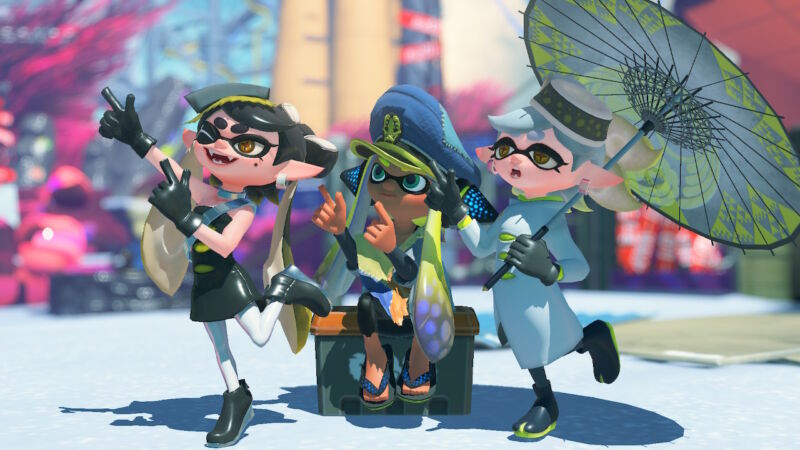
In the crustacean-filled universe of Nintendo shooter series Splatoon (sorry for the impending pun), something fishy is going on.
I'm not sure what Nintendo was thinking with its push of Splatoon 3, this week's brand-new sequel, as a replacement for 2017's Splatoon 2. Where the last game added meaningful new weapons and modes to the series' quirky online modes, this year's new model adds a sprinkling of online-only content, which at best leaves the formula unperturbed and at worst is in dire need of rebalancing. And while Splatoon 2 and its 2018 expansion pack delivered some of the best solo campaign content of the Switch's generation, Splatoon 3's equivalent is a slapdash mess.
Thanks to limited pre-release online testing, I can't definitively review that half of the game, and I'm wondering how much of it can be redeemed with post-launch support. But I'm comfortable enough to say that Nintendo has dropped the ball for series fans and created an unwelcoming mess for newcomers.
A bad case of the crab (tank)s

To explain how the series works, allow me to adapt the phrasing I used in 2017:
Splatoon has a few disparate parts: an eight-hour single-player campaign; a range of ranked and unranked multiplayer combat modes; and a "Horde"-styled multiplayer challenge mode, in which you and up to three others team up to take out waves of enemies. The game continues to operate in a universe dominated by Japanese-hipster "squid kids" who dress in "fresh" outfits and shoot paintball guns all of the danged time.
The series' default multiplayer mode, the "Turf War" team battle, returns as the touchstone Splatoon experience. Your team has three minutes to cover an arena's floor with more of your paint color than the opponent's, and any ground smothered in your color becomes "swimmable." Every player can tap a button to switch between a gun-toting teenager or a fast-swimming squid. Squids can hide or swim through their corresponding color of ink.
Splatoon 3 is so similar to its forebear that I didn't have to modify any of that text; all I did was remove a redundant reference to the series' first game on Wii U in 2015. My Splatoon 2 review went on to document smart changes to its online systems, which included a hearty expansion of available weapons, significantly improved level designs that emphasized verticality and sneaky tactics, and that quirky waves-of-enemies mode (known as "Salmon Run"), which turned out to be a pretty fun, kid-friendly version of a mode made famous by the likes of Gears of War and Halo.
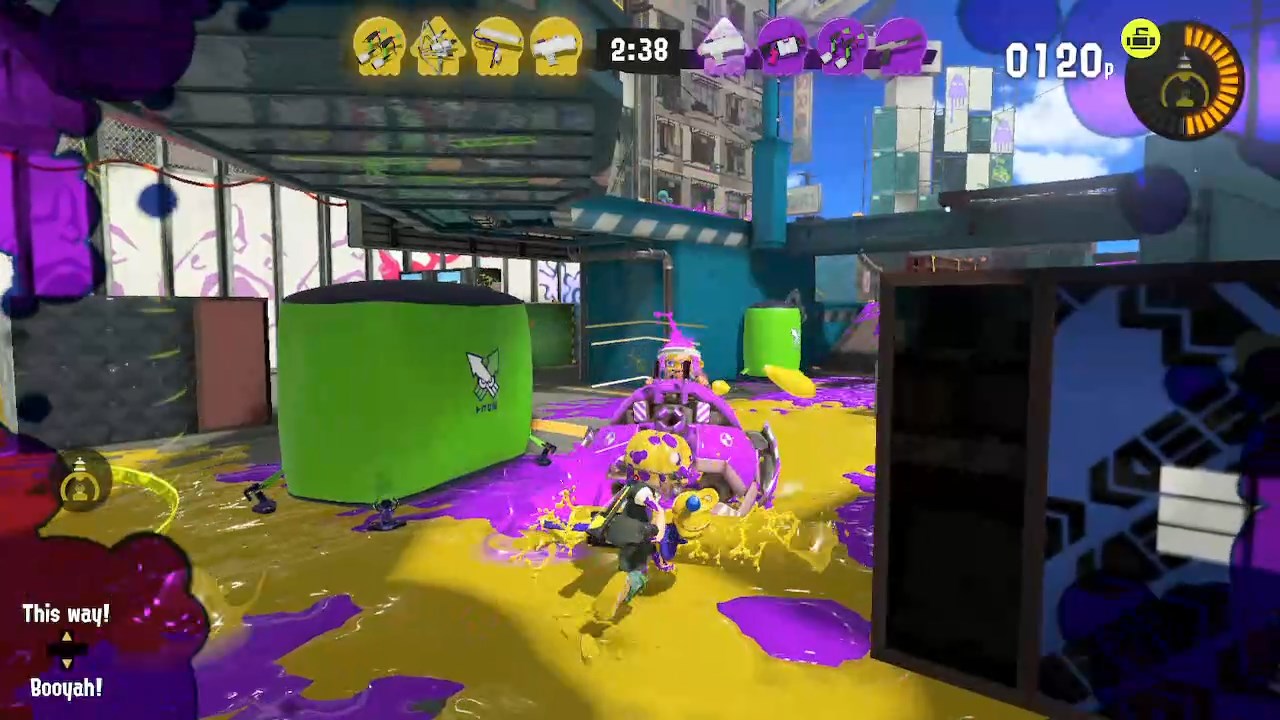 Trying (and failing) to kill the crab tank with a giant paintbrush.
Trying (and failing) to kill the crab tank with a giant paintbrush. Trying (and failing) to kill the crab tank with a pair of pistols.
Trying (and failing) to kill the crab tank with a pair of pistols.
What does Splatoon 3 add to online play? Not a ton. The biggest change is a new selection of "special attacks," which can be activated in an online game after laying down enough ink or doing enough damage to foes in a single life. In my limited online testing, these abilities immediately felt unbalanced—though their tide-turning powers don't figure as frequently in combat, thanks to how long they take to charge, so that impression is hard to quantify. One example is easy to point to, however.
The "crab tank" lets players temporarily turn into a slow, super-armored crab with unlimited ammo that shoots at a high rate of speed. I've already found that this tank is all but unstoppable when it faces off against one foe at a time; it's impossible to use the series' strongest up-close attacks and take the crab down before it can blot out any up-close combatant with its stream of paint. The best a team can hope for is that its opponent triggers the crab tank mode while surrounded by opponents.
Only five new maps (so far) for the series’ third game
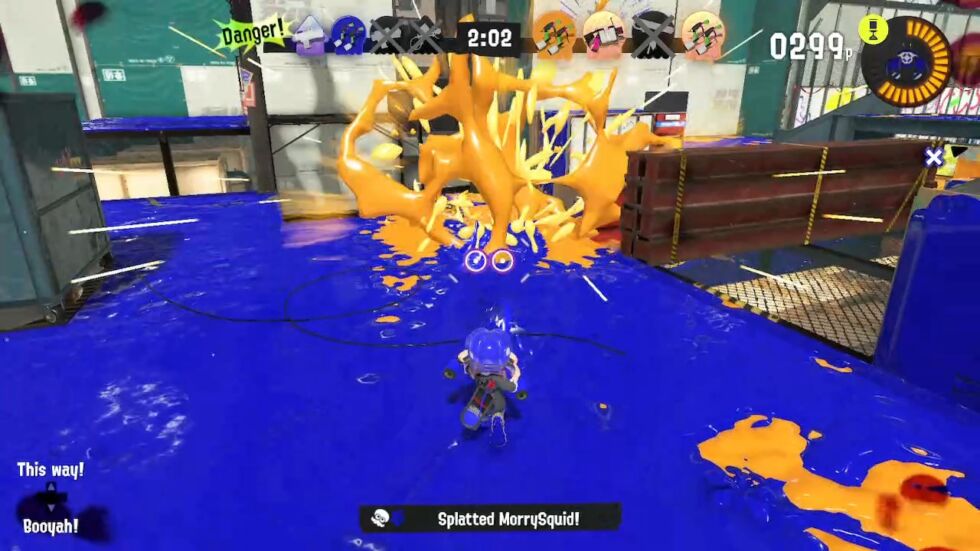
Other new special attacks include a grappling hook, which lets players zip into enemy territory, lay down opposing fire, then safely zip back to where they started; a vacuum pack, which temporarily sucks up enemies' paint (but only paint that they're actively shooting, not paint already laid on the ground, which makes this one a bummer); and a rideable missile, which lets players aim a massive shot at an enemy, then jump off once it delivers its payload to continue the assault. I was hoping to see more interesting changes to the primary weapon arsenal or some other interesting experiments with the series' "paint to win" mechanic, but instead, we simply have a three-pronged crossbow (which so far feels underpowered) and a quicker "samurai" version of the previous games' paintbrushes.
The sequel ships with 12 online battlegrounds for its Turf War mode, but only five of these are new; the rest are carried over from Splatoon 1 (three maps) and Splatoon 2 (five maps). Nintendo has made clear that it plans to gradually release more maps for Splatoon 3 over time, but the company certainly hasn't put its most ambitious foot forward with these maps. They don't feel particularly adventurous compared to the older games' material; if anything, they're a regression to the flatter level defaults found in the series' first game.
Thus far, Nintendo has only spiced up Turf War with one new "tri-color" variant, which pits one team of four against two teams of two. This mode sadly feels imbalanced in its current incarnation and unremarkable to boot; all Nintendo has done here is added another color to a given match, along with some controllable "sprinklers," which can help maintain color dominance for those who hold them. (Which, of course, is easier to do if you're on a team of four.)
Salmon Run has been upgraded with a few new boss monsters, and co-op teams will need to better coordinate their tactics and circle around these shielded beasts to beat them. If you have a family member who has bonded in online play with friends in Splatoon 2's take on this mode, this is the exact amount of new-content juice that might compel a purchase. But just like last time, Salmon Run pales compared to other incredibly deep co-op games that give players a lot more choice and loadout customization. Nintendo failed to upgrade this part of Salmon Run in any way; instead, every round, players are still stuck with a randomly selected weapon. The fact that Nintendo didn't upgrade this aspect would be funny if it wasn't part of a $60 retail package.
Why am I arranging items in a virtual locker that no one can see?
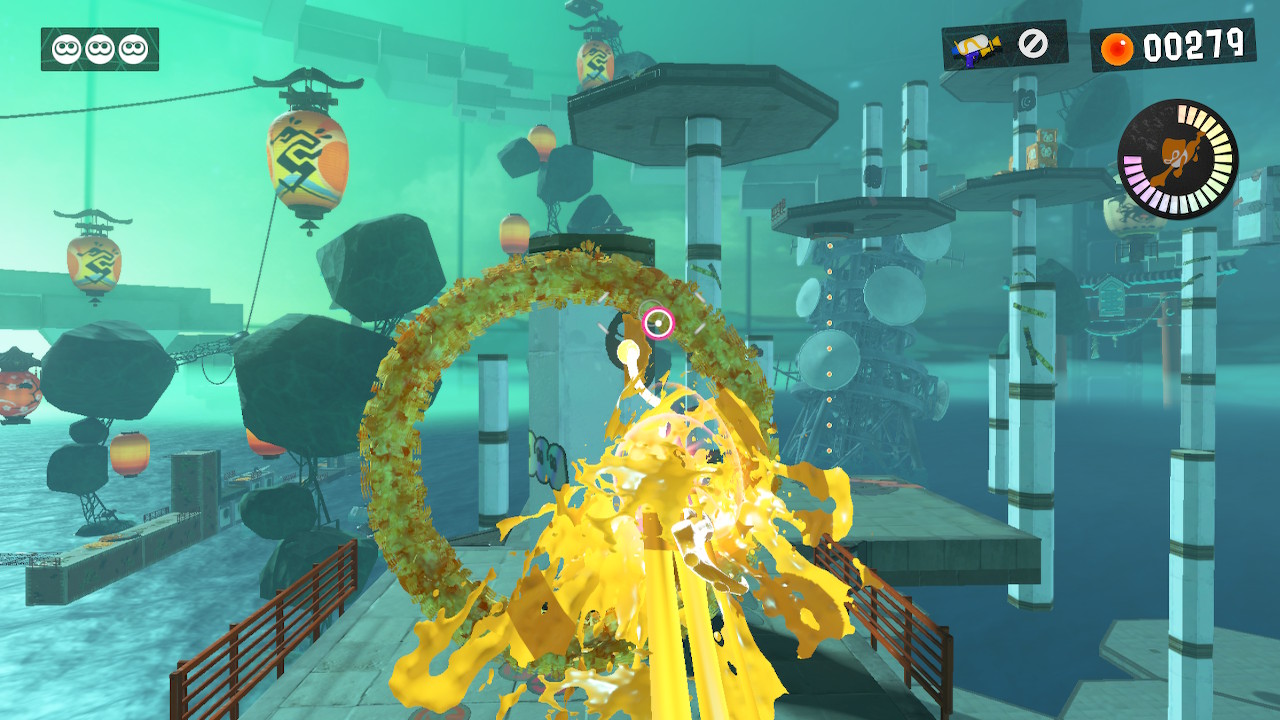 This scene looks cool as an isolated screenshot, but the copy-and-pasted geometry gets old in later levels.
This scene looks cool as an isolated screenshot, but the copy-and-pasted geometry gets old in later levels.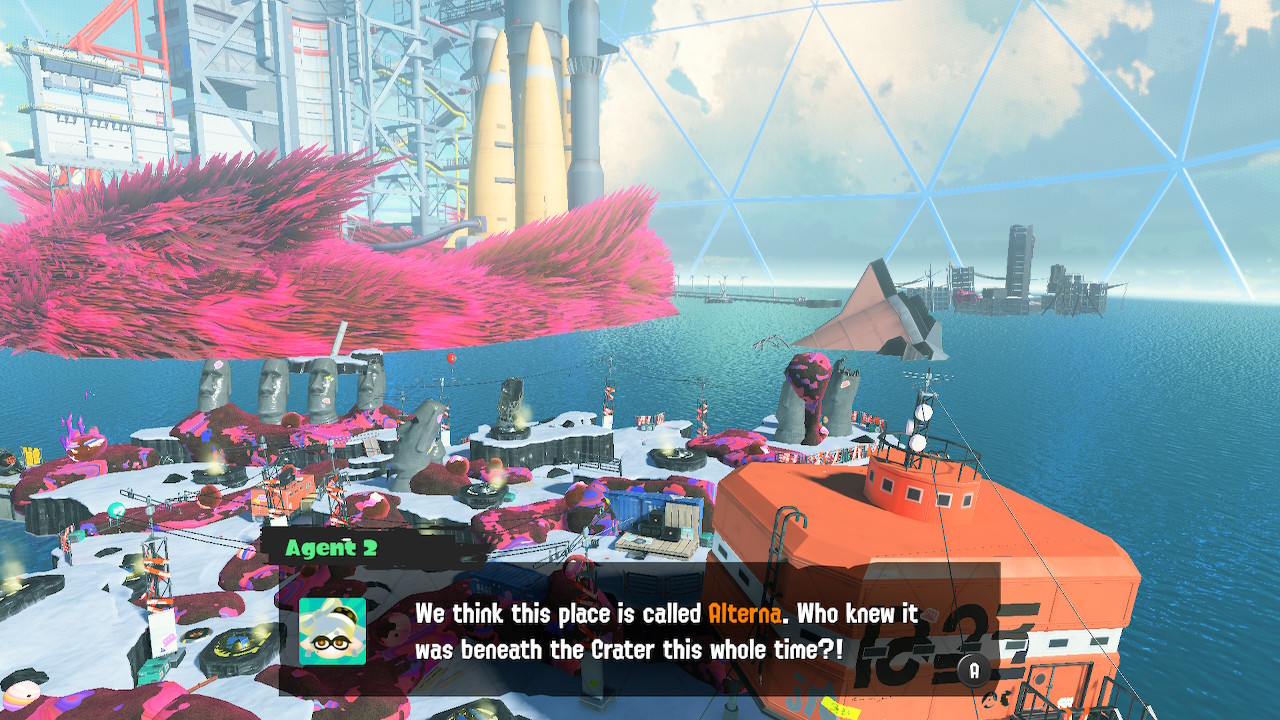 In this new overworld, you'll use accrued in-game currency to destroy massive oil-slick blobs and unlock new regions. However, many of these unlocks don't lead to new levels; instead, they merely unlock worthless cosmetics for a barely used locker interface.
In this new overworld, you'll use accrued in-game currency to destroy massive oil-slick blobs and unlock new regions. However, many of these unlocks don't lead to new levels; instead, they merely unlock worthless cosmetics for a barely used locker interface. I was hoping for more dynamic stuff from these flying machines, but you simply ride them in a straight line and avoid obviously telegraphed enemies.
I was hoping for more dynamic stuff from these flying machines, but you simply ride them in a straight line and avoid obviously telegraphed enemies.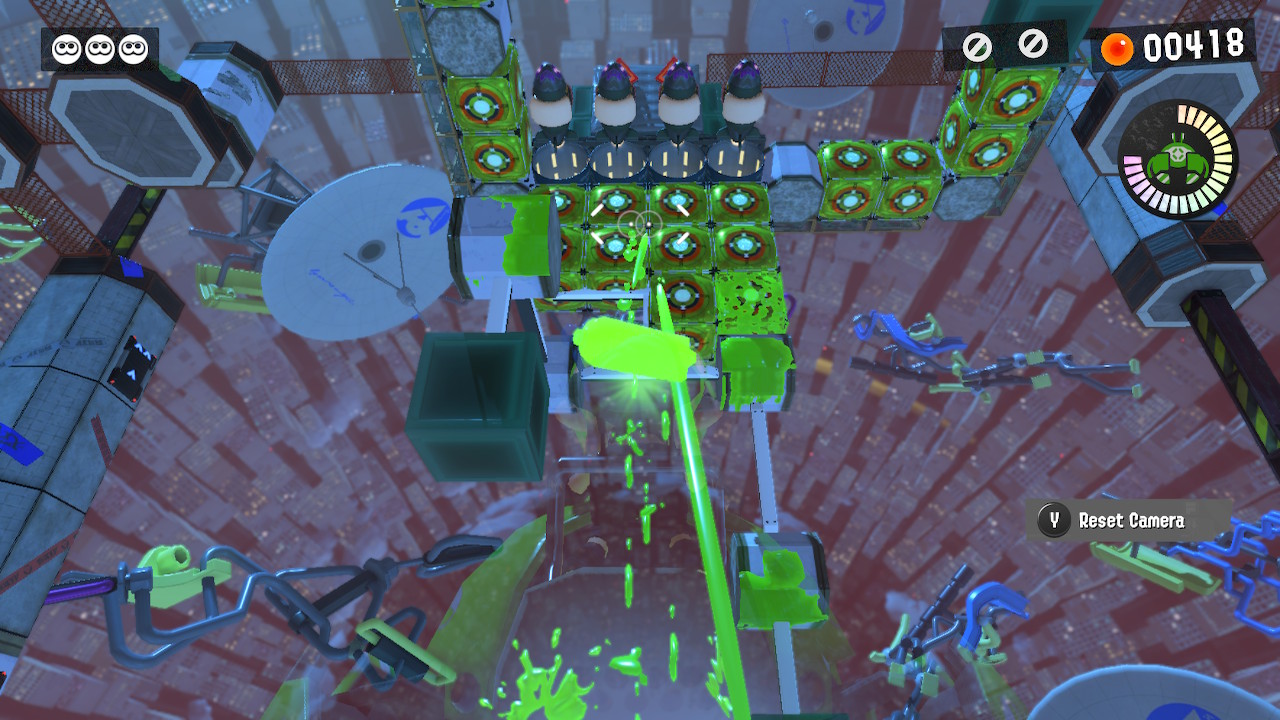 One of many unsatisfying boss encounters; this one is unwieldy to kill, one body-part box at a time.
One of many unsatisfying boss encounters; this one is unwieldy to kill, one body-part box at a time.
I don't need to log online to tell you how disappointing Splatoon 3's solo campaign portion is, however. The last game was a triumph of level design, as it took advantage of the Splatoon universe's chaos to deliver levels whose every element could spiral into the sky and expand in wild directions, all while players figured out creative ways to use paint in both combat and traversal alike. Nintendo endeared players to this otherworldly content by stitching every level together with the help of helpful mascot characters, who combined amusing dialogue with clear plot presentations.
Invert that entire positive description, and you have Splatoon 3's campaign. Most of the game's levels look and feel like they were made with a community modding toolset, all using the same geometry so often that the art team fails to differentiate the campaign's earliest levels from later ones. Worse, the levels often feel like time trial challenges with simple objectives and straight-line assault paths. But don't confuse "simple" with "easy," as many of these levels slam players into surprising walls of challenge, usually owing to an awkward issue with a timer or aiming difficulty.
Similarly, boss battles feel woefully undertested and suffer from agonizing spikes of challenge and confusion. There's also an overworld aspect of spending in-game money to unlock new paths, though many of the unlocks don't actually lead to new levels; instead, they only dole out cosmetics used to decorate a "locker" interface that is tucked into the very back corner of a single multiplayer lobby. (Decorating your tiny Splatoon 3 locker is perhaps the utter opposite of trimming a bonsai tree; the act of putting objects into your virtual locker is a nightmare of physics collisions and red Xs indicating that, no, you can't decorate your locker the way you want.)

And the plot is a mess of unclear objectives and unlikable characters, which is weird for a series that has developed a cult following for silly, good-cheer "pop star" characters like the Squid Sisters. Unlike the first two games, Splatoon 3 rarely made me laugh or smile while tapping through dialogue. I was also surprised by how bland the music in this new game turned out to be, as the series has otherwise been known for catchy, trippy tunes for so many years.
“You need to be online to do that”

If you'd like to get angrier at this package, here goes: Nintendo has newly instituted online-only checks for some of Splatoon 3's new content. All of your character's online-specific data is now tied to Nintendo's servers, so players can't access any of the game's cosmetic shops while they take their Switch anywhere offline. The same goes for a new card-battle game that has been added to Splatoon 3, dubbed Tableturf Battle; I was never even able to access a tutorial for the game, let alone any form of solo practice, since the mode didn't unlock for me until the game's pre-release servers had been shut off. (The solo campaign mode works when Switch is wholly offline, at the very least.)
Speaking of network woe: I was unable to play any of Splatoon 3 online without triangulating my Nintendo Switch's local IP address and opening up all of its UDP ports, which a Nintendo PR rep recommended I do because they had run into similar networking issues. The same Nintendo Switch, as connected via an Ethernet cable, can play online modes in Mario Kart 8 Deluxe, Super Smash Bros. Ultimate, and (most importantly) Splatoon 2 with no such port-opening exercises. This may be a wholly anecdotal issue that your home networking scenario won't replicate, but I point it out to clarify that your Splatoon 2 online experience may not necessarily carry over to this week's sequel.
If you're a Splatoon 2 diehard who wants more of the same on the online front, and you already have a dedicated friend group that can stomach however long Nintendo takes to balance things like the sequel's new special attacks, then you can likely expect a competent return to a series you already like. The same goes for parents who want to rest easy that they've handed their kids a solid online shooter that, thus far, has zero signs of paid microtransactions in any way, shape, or form. But as someone who fell off of the 5-year-old Splatoon 2 in favor of other games that my friends are more likely to log in to, I'm bothered by how little Nintendo has moved this series' needle.
Splatoon 3's existence feels like a corporate decision, meant to fill a release calendar, as opposed to being driven by good design ideas. I rarely find myself thinking that about a Nintendo game, but Splatoon 3 is that disappointing.
Verdict: If you were already eager to buy another Splatoon game, you'll find enough online fun here. If not, avoid (or pick up Splatoon 2 if you missed it the first time).
Ars Technica may earn compensation for sales from links on this post through affiliate programs.
Technology - Latest - Google News
September 07, 2022 at 09:00PM
https://ift.tt/IVZKl9d
Splatoon 3 review: Nintendo's well of squid ink has run dry - Ars Technica
Technology - Latest - Google News
https://ift.tt/jXiU8Ab
https://ift.tt/MbrzmBv


0 Commentaires